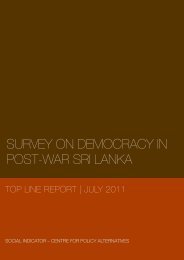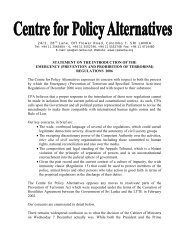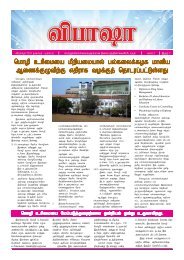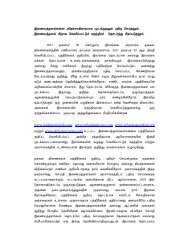States of Emergency - Centre for Policy Alternatives
States of Emergency - Centre for Policy Alternatives
States of Emergency - Centre for Policy Alternatives
You also want an ePaper? Increase the reach of your titles
YUMPU automatically turns print PDFs into web optimized ePapers that Google loves.
6.2.1 Structure and Content<br />
Viewed against international best practice in the design and<br />
structure <strong>of</strong> constitutional bills <strong>of</strong> rights aimed at guaranteeing,<br />
protecting and promoting human rights, the Sri Lankan bill <strong>of</strong><br />
rights is incomplete and structurally incoherent. The lack <strong>of</strong> a<br />
coherently conceptualised theory underpinning the Constitution<br />
that seeks to maximise the enjoyment <strong>of</strong> human rights by Sri<br />
Lankans makes hermeneutical interpretation <strong>of</strong> the bill <strong>of</strong> rights<br />
as a whole difLicult. This is reLlected in the fundamental rights<br />
jurisprudence <strong>of</strong> the Supreme Court over the last three decades.<br />
This lack <strong>of</strong> theoretical coherence in the Supreme Court’s<br />
fundamental rights case law is also partly due to its role as a court<br />
<strong>of</strong> Lirst instance in respect <strong>of</strong> fundamental rights, rather than as a<br />
constitutional court that enunciates general principles in the<br />
interpretation <strong>of</strong> the bill <strong>of</strong> rights. This aspect will be discussed<br />
further below.<br />
It is not clear from the text the basis on which the rights selected<br />
<strong>for</strong> inclusion were chosen, the order in which they appear was<br />
determined, or why certain textual <strong>for</strong>mulations were adopted<br />
when more liberal options were available. The three instruments<br />
<strong>of</strong> the International Bill <strong>of</strong> Rights, viz., the Universal Declaration <strong>of</strong><br />
Human Rights (1948), the International Covenant on Civil and<br />
Political Rights (1966) and the International Covenant on<br />
Economic, Social and Cultural Rights (1966) had been wellestablished<br />
in international law by the time the constitution was<br />
drafted in 1977 – 78, as had other regional instruments such the<br />
European Convention on the Protection <strong>of</strong> Human Rights and<br />
Fundamental Freedoms (1950). These could have provided useful<br />
guidance in designing the bill <strong>of</strong> rights, but apart from some<br />
textual evidence that the drafters drew from the UDHR and ICCPR,<br />
it seems as if the design and drafting was in<strong>for</strong>med by political<br />
212











